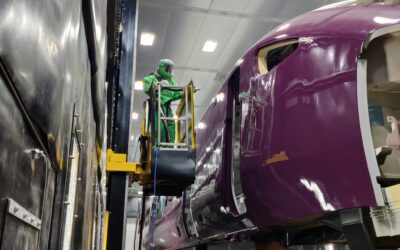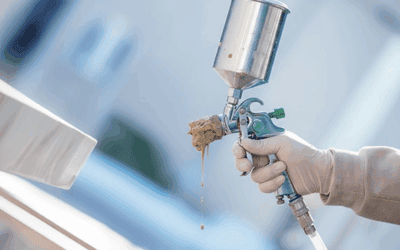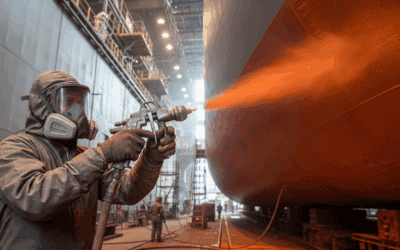Tips for achieving uniform colour coverage on large industrial surfaces
Achieving uniform colour coverage in industrial painting is essential – not just for visual appeal, but also for long-term protection and coating performance.
Large-scale projects like tanks, warehouses, structural steel, or heavy machinery require a methodical approach to spray technique, equipment setup, and environmental awareness. Below, we outline practical advice and expert-backed techniques to help you achieve consistent, professional coverage across expansive industrial surfaces – while avoiding common pitfalls like patchiness, streaking, or bubbling.
Why uniform coverage matters for coating integrity
Even, consistent paint coverage is about more than aesthetics. Uniformity plays a crucial role in protection, durability, and long-term maintenance. Uneven coatings can lead to bubbling, early wear, poor adhesion, and costly rework, and are a leading cause of early failure in industrial finishes.
Some industrial coatings – such as epoxies or zinc-rich primers – can significantly extend equipment lifespan and reduce maintenance when applied correctly. In fact, the right coating system applied with precision can reduce maintenance demands by up to 30%.
Start with proper surface preparation
Surface prep is the foundation of any successful industrial coating. Dirt, rust, grease, or existing flaking coatings all affect how paint adheres, which can result in blotchy, mottled finishes.
Practical steps:
- Thoroughly clean the surface using degreasers, blasting, or appropriate prep methods
- Remove contaminants like rust and old coatings
- Prime the surface using products compatible with your final coating and substrate
Note: For complex surfaces such as aluminium extrusions or powder-coated profiles, poor pretreatment can lead to thin spots and inconsistent coverage.
Choose the right equipment for the job
Your spray system and nozzle choice directly impact atomisation, flow rate, and finish quality. For large areas, airless spray systems offer both efficiency and consistency.
Pro tips:
- Use airless sprayers for broad, flat surfaces to speed up coverage
- Select a nozzle size that matches your coating’s viscosity
- Ensure your compressor delivers steady, sufficient air pressure for consistent atomisation
Spray painting large surfaces is ideal for reducing time and improving finish quality with less physical effort and greater consistency than brushes or rollers.
Maintain consistent spray technique
Operator technique is one of the most important factors in achieving a flawless finish. Inconsistent overlap, incorrect gun angles, or uneven movement can cause banding, streaks, or patchiness.
Practical steps:
- Maintain a consistent spray distance (10-12 inches is typical)
- Use 50% overlap between passes to ensure full coverage
- Always keep the spray gun perpendicular to the surface to avoid arcing
Applying paint in thin, even coats – rather than one heavy pass – helps prevent drips and surface defects.
Check and calibrate your spray settings
Spray settings should be checked before every job. Inconsistent pressure, clogged nozzles, or worn parts can all result in uneven application.
Practical steps:
- Test your spray pattern on masking paper or cardboard
- Adjust pressure settings to prevent tails or spitting
- Clean or replace nozzles and filters regularly
Consider environmental conditions
Temperature, humidity, and airflow all influence drying times and how paint settles. This is especially important for outdoor or semi-enclosed sites, where conditions can change rapidly.
Where possible, carry out painting in a controlled environment such as a spray booth or ventilated spray room. These setups help regulate airflow, temperature, and dust – ensuring a cleaner, more consistent application and faster curing times.
Practical steps:
- Avoid painting in high humidity or direct sunlight, which can cause uneven drying
- Stick to manufacturer-recommended temperature and humidity ranges
- Use a spray booth, spray room, or controlled enclosure to minimise airborne dust and regulate conditions for uniform application
In UK conditions, fluctuating temperatures and humidity can delay curing, affect adhesion, and cause brittleness in colder weather. A spray booth helps mitigate these issues and supports a consistent, professional finish year-round.
Work methodically in sections
Breaking the job into defined sections helps maintain a consistent approach. This prevents visible joins and promotes even drying across the surface.
Practical steps:
- Paint top-to-bottom and left-to-right (or vice versa), depending on structure
- Always maintain a wet edge to prevent dry overlaps
- Don’t rush – allow flash-off time if applying multiple coats
Use quality paints and mix correctly
Poorly mixed or low-quality coatings will compromise results regardless of technique.
Practical steps:
- Stir thoroughly to avoid pigment separation
- Follow correct mixing ratios (especially for two-pack systems)
- Strain paint to remove contaminants before loading into the sprayer
Common issues and how to fix them
Here’s a quick-reference table for resolving common coverage issues:
| Problem | Likely cause | Solution |
| Patchy finish | Inconsistent overlap or spray distance | Maintain 50% overlap and steady technique |
| Bubbling or blistering | Trapped moisture or poor curing | Allow proper flash-off; avoid humid conditions |
| Uneven thickness | Over-application or incorrect nozzle size | Use correct nozzle and build up in thin coats |
| Coverage gaps on edges | Incorrect angle or fast movement | Keep gun perpendicular and use controlled passes |
| Missed spots on grooves | Poor pre-treatment or application technique | Adjust spray angle and ensure pre-treatment reaches recesses |
Final quality control check
Once the coating is dry:
- Inspect under bright, natural light
- Look for mottling, banding, or uneven sheen
- Perform touch-ups where necessary to ensure full, even coverage
Final thoughts
Achieving uniform colour coverage on large industrial surfaces is a skill that combines the right preparation, equipment, technique, and environmental awareness. By following the tips above – and avoiding common pitfalls – you can dramatically improve the quality, durability, and appearance of your coating work.
Have questions about equipment setups or product compatibility?
We’re here to help you choose the right systems, materials, and application methods to achieve consistent, professional results on your next large-scale project. Get in touch for expert support.
Explore our full range of spray equipment, accessories, and spares, available to buy or hire.



